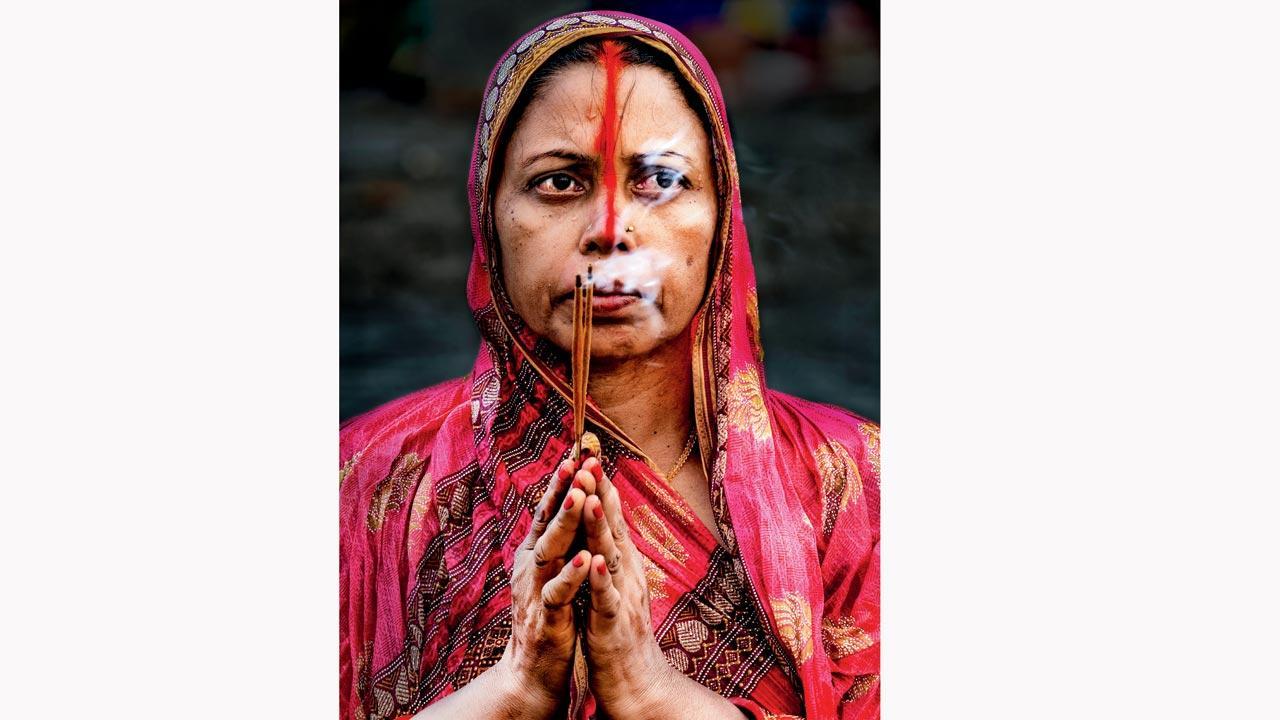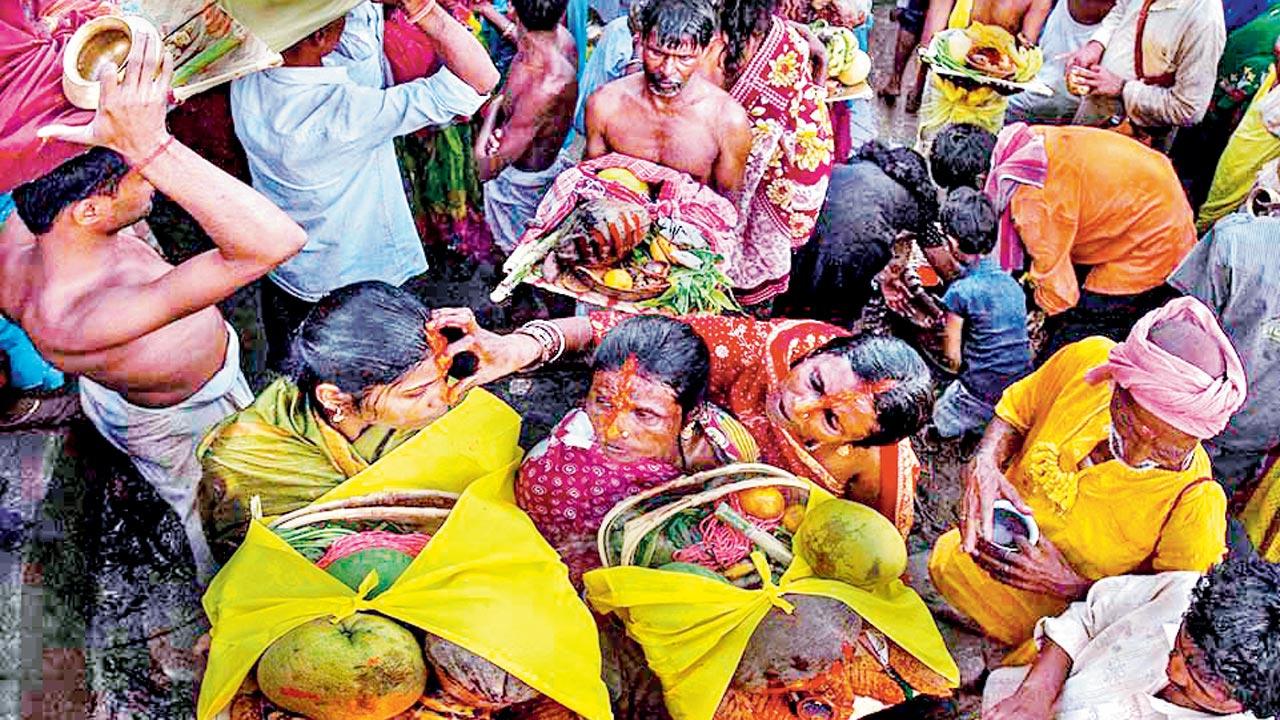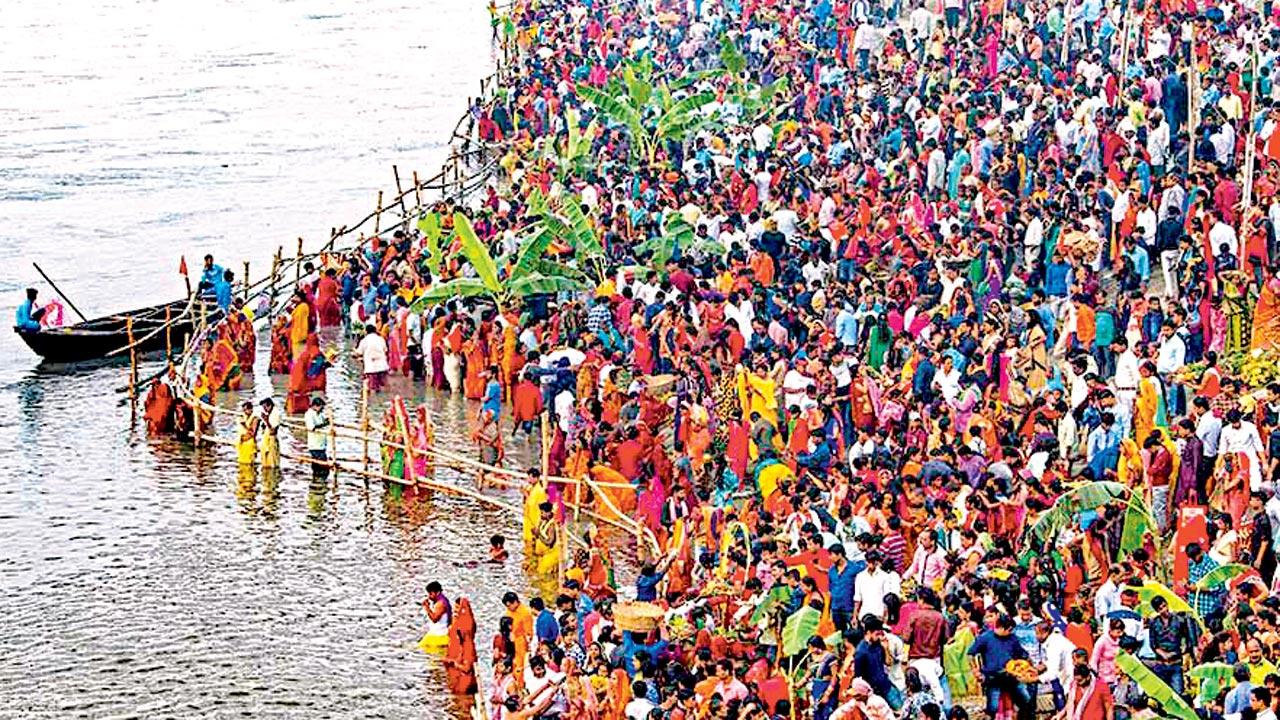Diwali is unlikely to overshadow a millennia-old festival revering the Sun god, inviting the faithful to soul search. A photographer documenting Chhath Puja over decades shares his frames with Mid-day

Photographer Shailendra Kumar’s pictures, like this one taken in Patna during Chhath Puja 2020, capture women who wait at the banks of the Ganga for the first rays of the sun to hit the water. For the next 36 hours, they observe a fast and stay indoors, with no one allowed to enter their house
The city of Mumbai, with its vast population from all over India, plays delighted host to a number of festivals every year. One of the major attractions for locals when it comes to the celebrations. From North India is Chhath Puja, when women flock to water bodies such as the Banganga Tank in Walkeshwar to perform the demanding and strict rituals to thank the Sun god and his sister—Chhathi Maiya—for their benevolence.
Which is why when photographer Shailendra Kumar’s pictures of Chhath Puja, performed at various banks of the river Ganga every year were featured at the Biennale at the Bihar Museum earlier this year, mid-day was immediately reminded of the enthusiasm and fervour with which the festival is celebrated in Mumbai.
 Women and children wash a saree of a Chaath observer on the last day as it considered to be ‘punya’. Phalgu river, Gaya (2014)
Women and children wash a saree of a Chaath observer on the last day as it considered to be ‘punya’. Phalgu river, Gaya (2014)
We caught up with Kumar, 63, on the phone as he was on his way from Delhi to Patna for the festival which falls this year between November 17 and 20. Kumar grew up by the sacred ghats of the Ganga, situated around the holy river’s South bank.
There are many stories surrounding Chhath, like the Pandavas observing a penance to win their kingdom back from the Kauravas. But seen through Kumar’s trained lens, it is an immersive experience, with sunlight and water playing with each other, while the devotees—with immense stamina and composure—meditate chest-deep in the Ganga, waiting for sunrise.
 Women gather on the banks of the Ganga to offer Kharna and fruits to the river—right before their 36-hour fast—in the city of Deo, close to Aurangabad in Bihar (2009)
Women gather on the banks of the Ganga to offer Kharna and fruits to the river—right before their 36-hour fast—in the city of Deo, close to Aurangabad in Bihar (2009)
Kumar admits that despite living in such proximity to the most revered river in India, he doesn’t identify as overtly religious. The reason the event got him curious enough to document it, was the fact that Chhath is one of the “quietest festivals”, he says.
“Growing up, I saw a lot of conflict around other festivals in Bihar. Chhath was the only time when neither religion nor vocation mattered. I have seen a known criminal, who was not even Hindu, sweep the streets during the entire duration of the festival,” Kumar tells us.
 The key ritual of Chhath is when observers begin to make they’re to the front of the line to offer prasad and are supported by families behind them. Hajipur (2018)
The key ritual of Chhath is when observers begin to make they’re to the front of the line to offer prasad and are supported by families behind them. Hajipur (2018)
The lensman, who has taken more than 500 photographs over the last 40 years, actually started off as a student of painting in Patna’s College of Arts and Crafts in 1980. He opted for photography as a minor, but while experimenting on campus, he found himself a camera—a novelty in those days—he informs. “I took my borrowed camera out for a spin on the morning of the first day of Chhath in 1983. Everyone was out there, shoulder to shoulder, helping and guiding and praying to the Sun, thanking him for the bounty of life,’ he recalls. For the next 10 years, Kumar documented Chhath with cameras that didn’t belong to him, and had to shell out a small fortune for them to be developed the ‘right way’, He finally set up his own dark room and purchased a camera—one of the most valuable in his collection of 25 cameras today.
The photographer says he loves the fact that he gets to play with light and shadow during the first rituals of the second day of Chhath, when the devotees consume the last meal they will have before starting a 36-hour fast—a prasad known as Kharna, which is a combination of fruits and coconut and cookies made out of jaggery dry fruits, as well as kheer, made out of jaggery. Then, they apply vermilion from the tip of the nose to their forehead, while men wear a turmeric coloured stole before they set off for the river.
 Shailendra Kumar
Shailendra Kumar
“Women play a big role in the vrat,” The rule is that once you observe Chhath, you can never skip it in your lifetime. It is only when a woman gets too old or very ill that she passes the baton to her daughter or daughter-in-law. This passing forward of the tradition also requires a particular ritual, where the family and the society at large are told that the next generation of women will be taking on the responsibility for the khandaan,” explains Kumar.
The Kharna, too, is sought after greatly. It is mostly cooked on wood fires, and relatives and friends visit to taste it. It is said that even a stranger cannot be turned away empty-handed if he comes to you seeking Kharna.
Kumar harks back to his 1983 documentation of the festival, which began at Badgaon, two km from Nalanda city. One of his favourite photographs from that time is a row of women in white sarees—the traditional Chhath attire—meditating.
“According to custom, one has to wear white, made from the same fabric as a dhoti. This fabric is first boiled and soaked with turmeric to signify that you are coming to the Sun in the purest form that is humanly possible. I found the serene and almost trance-like expressions of the women—as the first rays of the sun hit their faces—to be a spiritual experience myself,” Kumar recalls. He says the difference in how the festival is being observed today and how it was when he took the photograph is stark.
“Colour had no place in Chhath. Yet, today, we see loud reds accompanied by not-so-spiritual music take over in major cities, where Chhath is being observed, like Patna. Only in the villages can you still see the festival’s seriousness being retained,” says Kumar, before surprising us with sudden millennial lingo. “The idea of the festival has gone from being a period of introspection to something akin to FOMO—the millennial-coined concept of fear-of-missing-out. People now come for the grandeur, lot of emphasis has moved to physical appearance and so you see a lot of ornaments, instead of the purpose of cleansing your soul.”
Over the years Kumar has enjoyed documenting the nuances of the festival, like the women lining up plates or sieves along the banks. After the fast and the puja, the women go to the river once again and have their final bath. The sarees or clothes are then washed by family members in the Ganga and in the Ganga only. It is here that other people come and help family members, and strangers, to wash clothes as it is considered as punya to do so. Kumar observes that this tradition is steadfastly followed even in the Phalgu river near Gaya, which only has ankle-deep water throughout the year. Legend has it that Sita cursed the river after it incurred her wrath.
He hopes to publish a book some day. “Despite the water level being so low, people take the effort to wash their clothes, and the children join in. This is the uniqueness of Chhath— everyone helps everyone.”
 Subscribe today by clicking the link and stay updated with the latest news!" Click here!
Subscribe today by clicking the link and stay updated with the latest news!" Click here!










